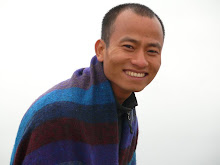MAE SOT, Thailand — One of the main organizers of the September protest marches in Myanmar, Ashin Kovida, a 24-year-old Buddhist monk, escaped to Thailand last week by carrying a false identification card, dying his hair blond and wearing a crucifix.
On Thursday, Ashin Kovida offered details of his harrowing escape and insights into what has remained a central question about the September protests: Who organized the orderly lines of saffron-robed monks who marched through Yangon - and how.
Ashin Kovida crossed the border to Thailand illegally and said Thursday that he was planning to request refugee status. He is wanted by Myanmar's military government, which accuses him of storing explosives in his monastery in Yangon, the largest city in Myanmar.
The monk called that accusation absurd.
In a six-hour interview in this border town, he painted a picture of a bare-bones organization, a group of 15 monks in their 20s who organized the September demonstrations. He said he had been elected leader of the group and had been inspired by videos of the popular uprisings in Yugoslavia against the government of Slobodan Milosevic.
The group received financial help from three well-known Burmese dissidents - an actor, a comedian and a poet - but did not receive any foreign assistance during their protests, Ashin Kovida said.
Eight of the 15 monks in his organizing committee are missing, he said. The other six, he said, are hiding in Yangon.
Known to have been arrested was Thin Thin Khaing, 42, whom he described as his adoptive mother. He said she was taken from her home in the early hours of Oct. 12. Her driver, Phoe Wa, was also detained, and their car impounded, he said.
Thin Thin Khaing has not formally adopted Ashin Kovida but served as his sponsor in the monkhood. Ashin Kovida said he believed that the authorities had detained her to put pressure on him to give himself up.
Hlaing Moe Than, 37, a lead organizer of students in the September demonstrations who also fled to Thailand, was shown a picture of Ashin Kovida on Thursday and confirmed the more recent refugee's identity.
"He is one of the famous leaders among the Buddhist monks during the protests," Hlaing Moe Than said.
Ashin Kovida led daily protests through Yangon from Sept. 18 through Sept. 27, the day after the authorities began raiding monasteries.
One of his main preoccupations, he said, was being able to feed the thousands of monks who had come to Yangon from other regions. He also worried about the presence of what he called "fake monks," who he suspected had been planted by the military government.
The spark for the demonstrations was warning shots fired by the police at monks on Sept. 5 in the central Burmese city of Pakokku.
"The first time I heard the information, I was speechless," Ashin Kovida said. "It was an unbelievable thing."
His fellow monks were outraged and looked for ways to respond. They decided to disengage themselves completely from the government, refusing all alms, support and contacts.
Older monks and abbots urged the monks to carry out their protests inside the monasteries, but Ashin Kovida said younger monks had defied those directives thinking that protesting within their cloistered world would not do any good.
Ashin Kovida reached out to students he had met during alms collections and began to plan the protest marches through Yangon.
"We realized that there was no leadership," he said. "A train must have a locomotive."
He said he had helped supervise the printing of pamphlets that would be distributed to monasteries, titled: "The monks will come out onto the streets."
"There were students and young people who were on our side," Ashin Kovida said. The students made up the pamphlets on their computers, printed them out and made photocopies.
"We had to do hundreds of them," he said. "We delivered to all the monasteries in Rangoon. We tried to distribute to other regions as much as possible." Yangon is also known as Rangoon.
On Sept. 18, he said, he led the first line of monks through the streets in Yangon.
On Sept. 19, a crowd of about 2,000 protesters, including 500 monks, was sitting on the tiled floor inside the Sule Pagoda when Ashin Kovida stood up and addressed them.
"To continue demonstrations in a peaceful way we must have leadership," Ashin Kovida remembered saying. "I call on 10 monks to come join me in the front."
Fifteen monks came forward, he said, the crowd cheering them on.
They formed what they called the Sangga Kosahlal Apahwe, the Monks Representative Group. Ashin Kovida was elected chairman.
Ashin Kovida then addressed the crowd again with a short speech.
------------
Original Link
THE LORD BUDDHA BLESS ALL OF YOU!
Total Pageviews
MY GUEST
categories
- about me (20)
- Arakan History (6)
- Arakan Tradition (2)
- Articles (6)
- Buddhism (2)
- Donate Here (1)
- News (120)
- Other News (35)
- Photos (18)
- report (7)
- Video (2)
archive
About Me
Followers
Copyright 2009 | Global Peace Centre
MobiPress Template designed by the Jinsona Design and XML coded by CahayaBiru.com














0 comments